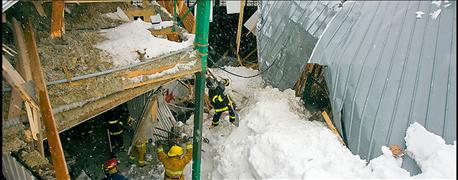
Even if your farm buildings escaped a major collapse from winter storm Jonas, now’s the time to do a close but careful assessment of potential structural damage. Curt Gooch, senior Pro-Dairy Extension dairy specialist at Cornell University notes that causes include but aren't limited to:
* Improper building design or construction
* Actual snow load exceeding design snow load
* Imbalance of snow load on roof
* Failure of a key truss or cross-bracing, causing others to fail

BEFORE THIS HAPPENS: No roof, no matter how well designed, is totally invincible from snow-load collapse. Take preventive measures.
Pre-engineered post frame agricultural buildings are designed to withstand a certain level of wind and snow loading below the “design value”, according to Gooch. For example, if the actual snow load is 30 pounds per square foot on a building designed for 40-pound snow load, there should be no load-carrying problem.
Unfortunately, many ag buildings haven't been designed for any particular snow load. They have a much higher probability of being weakened or failing as a result of past snow accumulations.
How heavy was it?
Snow load depends on snow depth and whether it's dry or wet. Here are four examples:
* One foot of dry snow weighs about 3 pounds per square foot; a foot of wet snow can weigh 21 pounds.
* Two feet of dry snow weighs 6.5 pounds per square foot; two feet of wet snow can weigh 42 pounds.
* Three feet of dry snow weighs 9.5 pounds; wet snow can weigh 62 pounds per square foot.
* Four feet of dry snow weighs 12.5 pounds; but wet snow can weigh in at 83 pounds.
Winter storm Jonas was predominantly dry snow. But with a follow-up rainfall or a wet-snow storm, the cumulative weight could prove troublesome.
Even well-designed ag roofs cannot withstand excessive amounts of snow, caution University of Minnesota Extension Ag Engineers Larry Jacobson and Kevin Janni. Wood truss structures will show stress before failing; metal structures often won't.
~~~PAGE_BREAK_HERE~~~
For a wood structure, the following audible and or visual signs may be noticed before roof failure:
* Creaking or moaning in the building
* Bowing of truss bottom chords or web members
* Bowing of rafters, purlins, headers or columns
If these signs are present, consider evacuating animals. Shoveling snow off the roof to relief loading is one option. But it may actually cause more damage than good by creating an unbalanced load.
What to do
When you begin wondering if snow is putting your building at risk, get it off as soon as possible, advises Jacobsen. Generally, there's time between a large snowfall event and possible structural failure.
Be aware of the human safety concern of working on a snow-covered and icy roof. Consider alternatives such as snow rakes or specialty tools that can be used from the ground or from portable scaffolding. Avoid excessive scraping on the roof or trying to chip off ice. They can damage the roof and lead to leaking.
Another option might be to warm the inside of more moderate-sized building sufficiently with large heaters to melt the ice layer. Then wait for the snow and ice to slide off.
Obviously, a lot of heat is necessary for even a moderately-sized building. It must be an open-trussed structure (no flat ceiling), and have an uninsulated metal roof.
If heat is used, continue until snow slides. Otherwise, ice will form and create another possible issue. Do not fire up heaters in flat-ceiling buildings due to the fire danger and the possibility of creating ice dams along the building's eaves.
About the Author(s)
You May Also Like




